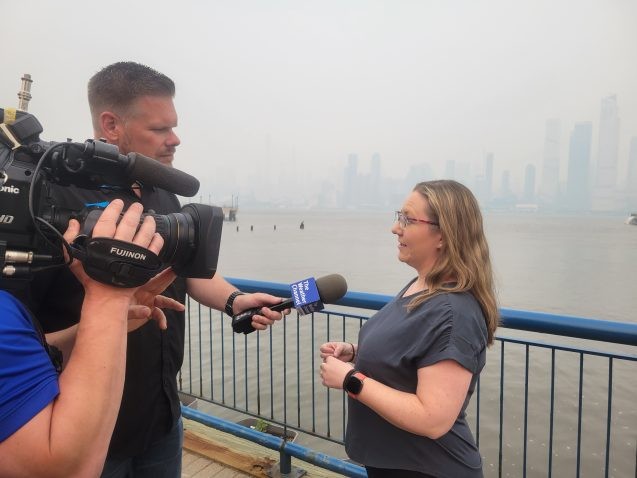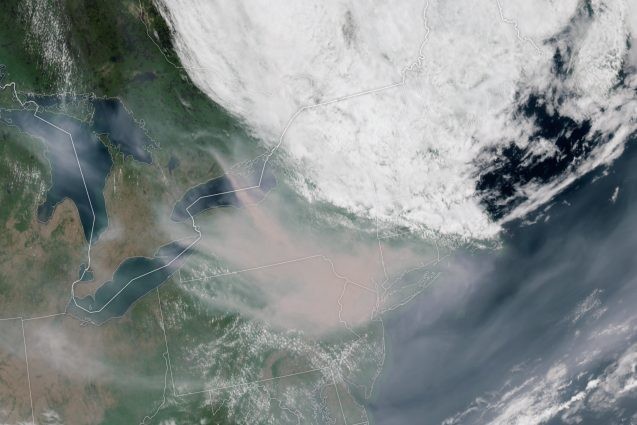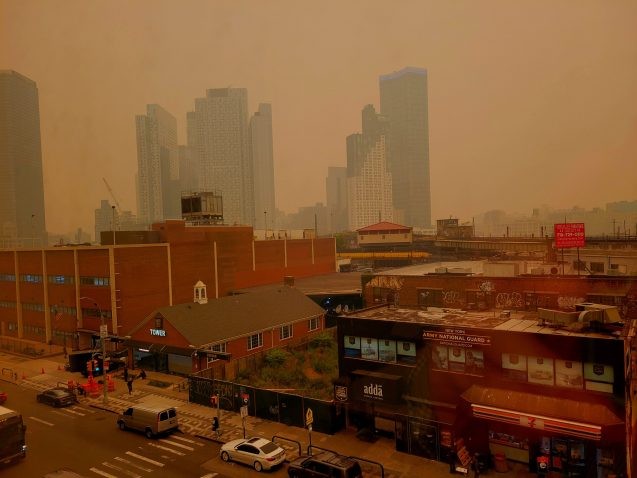How Wildfire Smoke Can Travel Thousands of Miles, and How to Protect Yourself
Columbia Climate School experts comment on the dangerous air pollution from Canadian wildfires.

More than 400 wildfires burning across Canada have triggered air quality alerts across a large portion of the U.S. In New York City, record-setting air pollution bathed the city in an ominous orange haze. Many reported smelling smoke, despite being thousands of miles away from the fires.
Experts at the Columbia Climate School have been featured widely in the news, using their expertise in meteorology, air pollution, health and disaster response to help put this unusual event into context. Below, we share some of their insights and guidance.
How dangerous is it?
“These levels are at least 10 times higher than what health guidelines mark as the healthy levels for exposure for particulate matter,” Dan Westervelt, who studies air pollution at the Climate School’s Lamont-Doherty Earth Observatory, told CNN. “So we’re really seeing just unprecedented amounts of pollution in the New York area and the mid-Atlantic in general.”
“How concerned you should be has a lot to do with your own situation,” Jeff Schlegelmilch, director of the Climate School’s National Center for Disaster Preparedness, told NPR. He went on to say that poor air quality is bad for everyone, but it’s especially dangerous for certain groups, including those with lung and heart disease, the elderly and pregnant people.
Róisín Commane, a Lamont scientist who monitors air quality in NYC and beyond, cautioned that air quality readings can be unreliable at very high pollutant concentrations. “I’m not sure there’s many things that can measure well when the numbers are this high,” she told Gothamist. “But once it’s above a certain amount, it’s toxic to people. So whether it’s 350 or 355 doesn’t really matter if you have to breathe it.”

How can I protect myself and my loved ones?
Climate School experts underlined the general advice to stay indoors with windows and doors shut if at all possible, and avoid strenuous activities.
“If you’ve got a red alert for air quality, it’s probably not the time to go out and go for that jog or go for that run,” Schlegelmilch told NPR, “because you’re breathing in more air and you’re breathing in more air more deeply.”
Turn on an air purifier if you can, Westervelt advised. And if you do need to go outside, a good mask can help out a lot, Steve Chillrud, who studies air pollution at Lamont-Doherty Earth Observatory, told local news media.
“The benefits are a good fitting K95 or N95 mask can remove the majority of the particulate matter, which is what is causing the haze,” he said. “The fit is the most important, so even wearing a surgical mask that fits you well can help, but a K95 or N95 mask can work better.”
In one interview, Climate School PhD candidate Garima Raheja raised concerns about the city’s most vulnerable residents, including unhoused people. Read about how the city is trying to address this problem in this City Limits article.
How is the smoke traveling so far?
In a fascinating interview with Curbed, Dan Westervelt details how heat from the wildfires helps to propel smoke particles high up into the atmosphere, where they can then hang out for weeks, hitching a ride on the prevailing winds.
Speaking with the New York Times, Westervelt added that a low-pressure system in upper New England is creating the perfect conditions for wind to bring the smoke down the East Coast.
How long will this last?
While Canada struggles to get its record-breaking number of fires under control, smoke will continue to enter the atmosphere. Where that smoke travels depends mostly on meteorology, including wind patterns and rainfall, which can help to clear the air.
Westervelt told Bloomberg that the smoky haze is likely to remain in the Northeast for the rest of the week, before blowing out toward the ocean. “I would expect things to start to get a little bit better as we get closer to the weekend, but the fires are still burning,” he said. Changing weather patterns may bring “a little bit of relief, but it’s not going to be an overnight switch. It might take a bit of time for all the smoke to clear out.”

Is climate change a factor?
In the CNN interview, Westervelt explained that it can be difficult to say definitively whether climate change has caused a specific event such as this outbreak of wildfires. However, he added, scientists are no doubt already investigating this question.
“What we do know,” Westervelt said on CNN, “is that hotter temperatures, drier conditions, worsening droughts, less precipitation — all of those things which are symptoms of climate change — are happening, and those things do worsen wildfires.”
In an interview with ABC7, Radley Horton, a climate scientist at Lamont-Doherty Earth Observatory, goes further in depth into what scientists do and don’t know about how climate change influences wildfires. Watch the interview below:
